A Fredericksburg in the West: A Witness to the Chickasaw Bayou Fight
On the morning of December 29, 1862, the 6th Missouri drew the task of spearheading a Union attack across a narrow neck of land along Chickasaw Bayou. The ridge beyond was lined with Confederate artillery batteries and rifle pits which made the perilous assignment something that made even veteran troops hesitate before attempting.
“There was
some hesitancy as to which company would cross first and finally Co. F
volunteered and were duly accepted by the colonel,” one soldier noted. “They
crossed the bayou followed by a portion of Co. K who had been detailed to make
a road up the opposite bank which was very steep and right upon the top of
which were Rebel sharpshooters in their rifle pits. After the completion of the
road, the balance of the regiment was to cross. But this idea was finally
abandoned and in about an hour and a half the whole regiment had reached the
opposite side. A portion of Co. K who had crossed with spades and shovels
commenced digging, but it was found to be useless and too perilous. Directly over
their heads were Rebel rifle pits so close that some of the boys of Co. F
locked bayonets with the Rebels.”
This account of the Chickasaw Bayou campaign was written by a soldier of the 6th Missouri Infantry under the nom-de-plume of “Yank.” The letter was published in the January 30, 1863, edition of the Weekly Pioneer & Democrat of St. Paul, Minnesota. The 6th Missouri was part of Colonel Giles A. Smith’s First Brigade of General Morgan L. Smith’s Second Division of Sherman’s 13th Army Corps. Other units in the brigade included the 113th Illinois, 116th Illinois, the 8th Missouri, and the First Battalion of the 13th U.S. Infantry.
On board U.S. transport Universe,
near Napoleon, Arkansas
January 17, 1863
Sherman’s
army corps marched to the Tallahatchie River in Mississippi and formed a
junction with the remainder of Grant’s army and encamped for a few days. In the
meantime, a consultation having been held by the commanding generals, it was
deemed advisable that the division commanding by General Morgan L. Smith should
return to Memphis. We arrived at Memphis on December 13th and found
General George Morgan of Cumberland Gap notoriety with his command encamped
there.
After
a few days consumed in active preparations, we received orders to embark and
accordingly went on board the numerous boats waiting to convey us down the
river. On the evening of the 20th our splendid fleet set sail down
bound for the express purpose of capturing the last hold of the Rebels on the
Father of Waters, Vicksburg. Nothing of more than ordinary interest transpired
on our voyage. On the 26th ultimo we landed a little above the mouth
of the Yazoo River and pitched tents. After passing Helena, Arkansas, General
Steele’s division fell in our rear and accompanied us down the river.
On
the morning of the 27th, our troops having marched out a few miles,
the Rebels commenced throwing shells at our advance. This opened the ball. I
cannot attempt anything like a detailed account of the movement of the troops
under Morgan and Steele but shall confine myself particularly to the part
assigned to the First Brigade of the Second Division as my knowledge of the
disposition of this portion of our force is more explicit. Our brigade was
commanded by acting brigadier Giles Smith and the division by Morgan L. Smith.
General
A.J. Smith’s division held the extreme right, Morgan L. Smith’s next on the
left, Steele’s in the center, and Morgan’s on the extreme left of our line. The
total force is variously estimated but I do not believe that it exceeded 30,000
men. On the right in front of our men was a bayou of about 150 yards in width.
In the rear of this bayou, a short distance, appeared a prominent ridge
intersected by ravines. This ridge was strongly fortified by the Rebels with
numerous masked batteries and rifle pits and from our position we could discover
the Rebels moving to and fro. The hill or portion of the ridge directly
opposite the position held by our right seems to have been considered by the
Rebels (and very wisely) as the most important point of defense.
It
was determined to storm the hill and deemed advisable to build a bridge.
Accordingly the 54th Ohio and 55th Illinois regiments
were detailed to make the attempt, but after several endeavors in the face of
almost incessant fire from the Rebel rifle pits, the project was abandoned as
impracticable. The enemy’s fire was too hot. They had every advantage of us;
from the opposite bank of the bayou were rifle pits in which the Rebel
sharpshooters were entrenched. While superintending the attempting building of
the bridge, our brave intrepid General Morgan Smith was wounded severely by a
rifle ball penetrating just above the right hip. This was most unfortunate for
us as the wounding of General Smith at this time contributed chiefly to the sad
results that followed in my humble opinion.
 |
| Captain Charles O. Patier Co. K, 6th Missouri Infantry Note the 15th Army Corps badge on his breast |
With
his accustomed coolness, he rode up to a battery nearby and remarked, “Boys,
throw a few shells in there. I’ve got one of their balls and must go back to
the rear.” I am informed that the ball has not yet been extracted. The General
is, I am happy to state, in a fair way to recover; may he see many Rebels fall
before the steady fire and determined tread of his gallant boys who would
follow him to the cannon’s mouth! After our General Smith was wounded, General
A.J. Smith assumed command of the Second Division on the morning of the 28th.
General Stuart’s brigade of the Second Division having been in the advance was
relieved on the morning of the 29th by Giles Smith’s brigade consisting of the
6th and 8th Missouri, 13th Regulars, and the 116th
and 118th Illinois regiments, the latter regiment not having been on
the field because of the inefficiency of the arms furnished to it by the
government. The brigade had previously been in the reserve. The 6th
Missouri was assigned the advance in the brigade.
After
the abandonment of the bridge-building, a narrow neck of land was found
crossing the bayou and by this route only could our troops cross. This was
passage was well-known to the enemy and thitherward they directed their too
accurate fire. But the bayou must be crossed, and the hill stormed! The
Generals in immediate command hesitated as it was too desperate an attempt. The
Rebels fortified on every hand and every advantage of position, it was too
great of odds to contend against, but General Sherman’s orders are peremptory,
they must cross. It looked and many believed that death would be the inevitable
result to each and every man that attempted it. Artillery had poured volley
after volley, shell after shell had exploded among them, killing doubtless hundreds
of the enemy, yet they still held their position, and the growl of the bulldogs
was ineffectual.
 |
| Lieutenant Colonel James H. Blood 6th Missouri Infantry (U.S.) |
The only
method that remained was to rout them by an infantry charge. It required men of
the most undaunted courage, men old in service whose bravery and endurance were
beyond question, to make the fearful effort. The 6th Missouri as I
said before being in the advance was to be the first to pass through the
perilous ordeal. Under the command of Lieutenant Colonel James H. Blood, who
has for a long time commanding the regiment, the 6th was ready to go
where duty called. There was some hesitancy as to which company would cross
first and finally Co. F volunteered and were duly accepted by the colonel.
They
crossed the bayou followed by a portion of Co. K who had been detailed to make
a road up the opposite bank which was very steep and right upon the top of
which were Rebel sharpshooters in their rifle pits. After the completion of the
road, the balance of the regiment was to cross. But this idea was finally
abandoned and in about an hour and a half the whole regiment had reached the
opposite side. A portion of Co. K who had crossed with spades and shovels
commenced digging, but it was found to be useless and too perilous. Directly over
their heads were Rebel rifle pits so close that some of the boys of Co. F
locked bayonets with the Rebels. The pits were occupied by the 42nd
Georgia and 17th Louisiana regiments.
On
the other side of the bayou, the 13th Regulars were deployed to the
right and left of the passage or neck after which they kept up a continual fire
in the direction of the Rebel fortifications, thus as far as possible,
protecting the 6th from annihilation. While I cannot but regard the
order to cross from whatever source it may have originated as rash and absurd
in the extreme, yet I and every true citizen of this distracted country must
admire and applaud the daring bravery and unflinching devotion of those men who
willingly obeyed it. The 8th Missouri also afterwards came up and
assisted the 13th Regulars.
Sixteen
of the gallant 6th Missouri lie entombed in the once honored soil of
Mississippi. Green grows the sod over them and may no traitor’s foot pollute
it. Lieutenant Robert L. Vance was the only commissioned officer killed; a
noble, high-minded man, a good soldier, attentive to his duties, an ardent
lover of his country and devoted to her cause, we miss him! He died like a
brave and gallant officer and on the banks of the Yazoo he slumbers. May the
waters flow gently, and southern winds be hushed as they pass his resting
place, alone and solitary, in the land of the stranger and the enemy.
Of
Lieutenant Colonel Blood, too much cannot be said. He shared the peril with his
men and although twice wounded, never flinched. The Rebel balls fell thick and
fast around him, but he remained cool and collected, never gave up his command,
but remained at his post, resolved to do or die as the case might be with his
gallant followers. Verily, he deserves well of his country. May the Rebel balls
ever prove as harmless to him as on the present occasion.
But
there is a finale to all this gallantry, heroism, bloodshed, and death that
shrouds it in a great measure in dissatisfaction. Was it all in vain, this
sacrifice of blood and treasure? This remains for time to divulge. Was Sherman
out-generaled? It certainly appears so! It is stated that General F.P. Blair’s
brigade was fearfully decimated. Our total loss is estimated at 1,700. Who is
to blame? Who assumes the responsibility? I await developments.
Yank
Source:
Letter from “Yank,” 6th
Missouri Volunteer Infantry, Weekly Pioneer & Democrat (Minnesota), January
30, 1863, pg. 3












Comments
Post a Comment